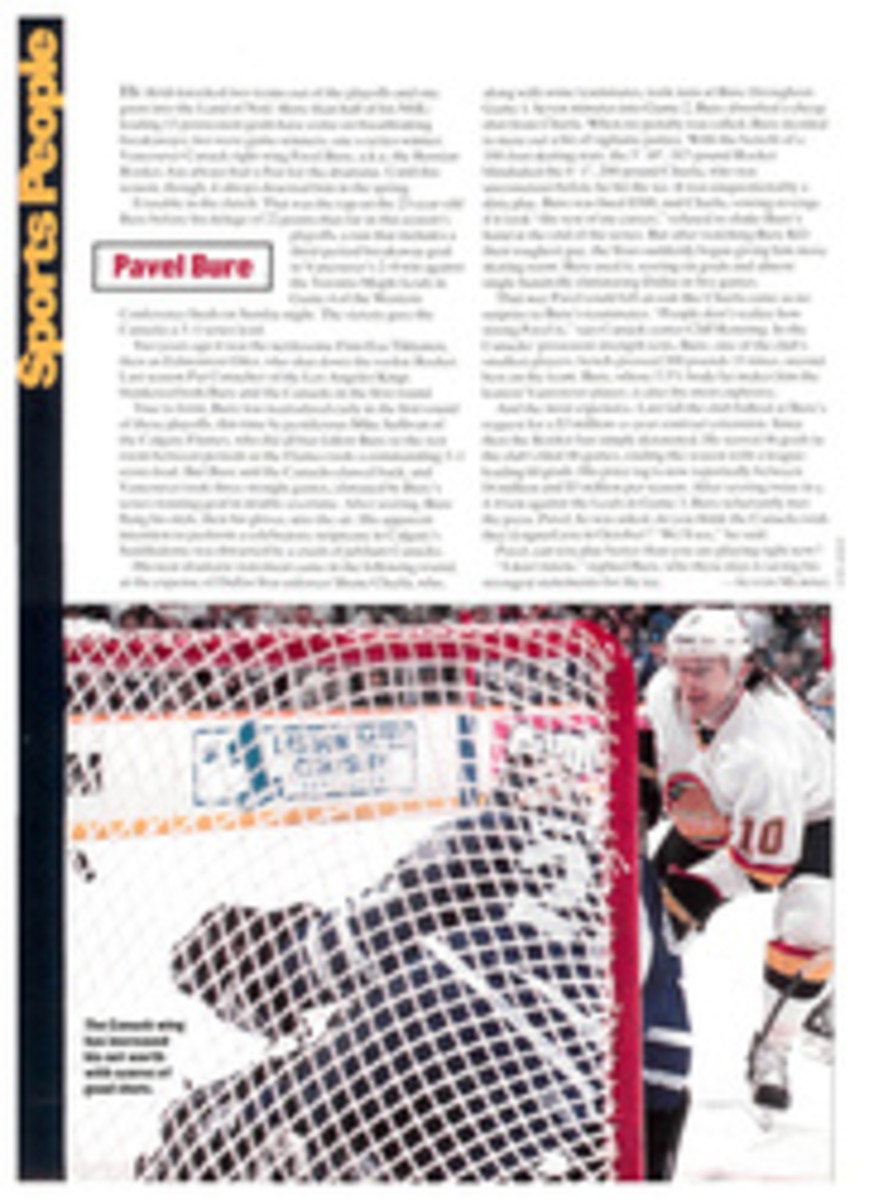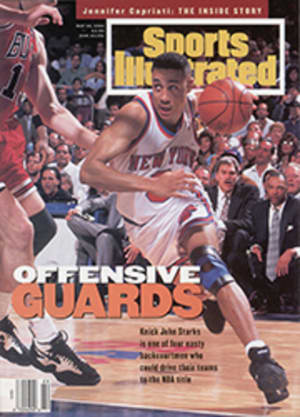
Rasslin' with Hard Times
The last cowboy hero of the Wild West works in a 10-by-20-foot office in the athletic department of Montana State University in Bozeman. His name is John Larick, and he is the coach of the Bobcat men's and women's rodeo teams, the most successful college rodeo programs in North America. Larick's teams have won four national championships in the last nine years, and every high school kid in the West who can rope a calf dreams of being coached by Larick. Some years he receives more than 1,000 applications for the three or four openings on each team.
But widespread adulation, it turns out, is no match for fiscal trouble. In March 1993, in the middle of the rodeo season, Larick was informed that because of severe cutbacks in the athletic budget, the university could no longer support rodeo as a varsity sport. The coach was given 60 days to cither raise all the money needed to run the rodeo program—more than $100,000 a year—or clear out his office and depart.
Some coaches would have shrugged their shoulders and left—especially a proven winner like Larick, who could have landed another job at the drop of a ten-gallon hat. But Larick didn't want to leave. Rodeo in Montana is like basketball in Indiana, and Larick is Montana's Bob Knight, only with fewer temper tantrums and more national titles. And Bozeman is especially cowboy crazy: It hosts the annual College National Finals Rodeo, the sport's Final Four. More than 5,000 people, in a town of 22,600, filled State's held house every night during the weeklong finals last June. (This year's finals are June 14-19.) If you're going to coach college rodeo, Bozeman is the place to be.
Larick had been there 11 years when the university announced its intention to eliminate rodeo. During Larick's tenure the program was transformed from an unwieldy agglomeration of more than 60 athletes of varying abilities to a streamlined powerhouse with 30 members (20 men, 10 women). Cutting the size of the teams allowed Larick to treat his athletes like members of an extended family. Photos of graduates hang on his office walls like pictures of favorite grandchildren, and Larick can point to each one and tell a story about a great rodeo moment or an expected child or a recent job promotion. It is not unusual for a half-dozen current team members to be boarding with Larick and his wife, Pat, on their 11-acre ranch, the J Lazy L.
Larick's teams win; many of his athletes depend on scholarships for their education; four world champions and three of the top 15 competitors on the pro rodeo circuit are Larick's former students. No, Larick decided, he would not leave Montana State just because the school was broke. In ranch country, Larick knows, the dollar isn't the only currency, especially during a recession. With nothing to lose, Larick decided to fund his rodeo teams the cowboy way: He would stage a good old-fashioned roundup.
Larick, 48, looks like a cowboy. He wears bright-blue Wranglers and enormous belt buckles and freshly starched flannel shirts. His thin, clean-shaven face is usually shadowed by the brim of a well-creased cowboy hat. He pronounces wrestling rasslin' and creek crick, and his lips twist around a large plug of tobacco as he talks.
Larick grew up in Kilgore, a one-store town in southeastern Idaho. He could ride a horse at two; in high school he became a rodeo star. Upon graduating, in 1964, he joined the pro tour and competed until the day in 1969 that a bull stepped on him, damaging his pancreas and spleen and most of his ribs. He took up coaching two years later and worked at Hartnell Junior College, in Salinas, Calif., for 11 years. There he elevated a tiny program to a perennial contender for the national title. Arriving at Montana State in 1982, Larick began turning out a remarkable string of individual and team champions.
"Rodeo is different from other college sports, and because of this we became the sacrificial lamb," Larick says, referring to the university's intention to drop the sport. Rodeo is not, for example, an NCAA sport. The 130 teams throughout the U.S. and Canada are members of the National Intercollegiate Rodeo Association (NIRA), whose rules are a bit different from those of NCAA sports. College rodeos, for instance, offer scholarship money as prizes (in the finals, each winner receives $1,500), and athletes are encouraged to compete in pro events during summer vacations. "Schools don't supply rodeo athletes with equipment, so my kids come here with $50,000 worth of gear apiece—they need horses and saddles and pickup trucks and trailers," says Larick. "If you tell them they can't compete for money, how the heck are they going to be able to pay for it all?"
The school's decision to dump rodeo owed something to these differences. In 1993, state funding for the school was severely slashed, and at the same time the NCAA decreed that all colleges had to have 14 athletic teams in order to retain Division I status. Montana State had 12. The strain of dealing with massive cuts and adding two more sports and supporting a non-NCAA team was too much for the school. Rodeo had to go.
The choice was understandable. "I didn't expect them to close the library to save rodeo," says Larick. Besides, rodeo could continue—with or without Larick—as a club activity, a status shared by many of the NIRA's top teams. What Larick couldn't understand, however, was the administration's decision to deny the rodeo team funds from the school's Steer-a-Year program, a money-raising scheme under which local ranchers donate young steers to Montana State athletics. The animals are fattened on the school's feed-lots, and then they are sold to a meat processor to help fund the teams. Since it was assumed that the rodeo teams motivated many of the ranchers to give livestock to the school, a portion of the money from Steer-a-Year was traditionally offered to Larick's program. But the deal had never been put in writing, and the administration decided that since rodeo was no longer a varsity sport, it would no longer be entitled to Steer-a-Year benefits.
"I had believed we were going to be treated fairly, but once the administration decided to cut me out, that's when the worm turned," says Larick. "So I decided to hit the road like a Fuller Brush man." Larick got on the phone to his former team members and asked them to set up town meetings with local ranchers. His plan was to plead for steers to be earmarked specifically for the rodeo program. All the times he had treated his team like family paid off. The meetings were arranged quickly, and last spring Larick raced across the West selling his program.
The response was overwhelming. Despite the sour economy, pledges from ranchers poured in. Bozeman's local country radio station, KBOZ, started its own Save the Rodeo campaign, and fans throughout the state sent whatever they could afford, often as little as five dollars. By the time Larick's 60 days were up, on June 13, he had raised more than $100,000 in cash and livestock. The haul was enough to cover his teams' expenses, fund his athletes' scholarships and pay his own salary.
Catastrophe was averted, or so it seemed. The scramble for funding disrupted practice time, and at the 1993 national finals the Montana State women finished a respectable third, but the men's team, considered one of the favorites, placed a disappointing 15th.
This season, Larick was again forced to deal with financial problems. His herculean efforts raised a remarkable amount of money, but only enough to cover expenses for one season. "It was D day all over," says Larick. "I'd tapped my friends and alumni plumb out, and now I had to find more money."
Last week, in an 11th-hour effort to save his program, Larick met with Montana State's administration. The coach explained that if the university were to drop rodeo, attendance at the national finals would suffer, which, of course, would affect the school's finances because it hosts the event. He made his point. Montana State's president, Michael Malone, agreed to fund the program. "I don't think the administration truly understood our program," says Larick. "The athletic director is in a tough position. He is supposed to run men's and women's sports and do it under the guidelines of the NCAA. At a time when he needed to make cuts, rodeo was, and still is, the only non-NCAA sport supported by the school. So that was the place to cut. But the president and the vice president weren't that close to our finances. This was first time they had a chance to see the impact MSU rodeo has on the school in terms of the funding that we brought in."
Now that his teams can pay their bills, Larick expects to raise enough money to start an endowment fund that will guarantee Montana State rodeo's future. Of course the coach is delighted with the recent turn of events. But even as the demise of his program appeared likely, Larick remained optimistic. "Rodeo's been in my blood my whole life," he says, "and if there's one thing it's taught me, it's how to react quickly in a crisis."
PHOTO
MARK MACLEOD
Larick pared down the Bobcats' unwieldy teams and coached them to four national titles.
TWO PHOTOS
MARK MACLEOD
Montana State's athletes need expensive equipment, saddles included, to be competitive.
Michael Finkel lives in Bozeman, Mont., and contributes often to Sports Illustrated.

